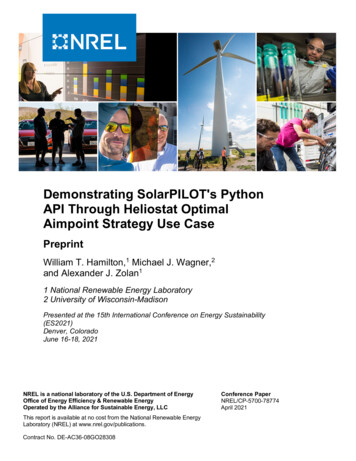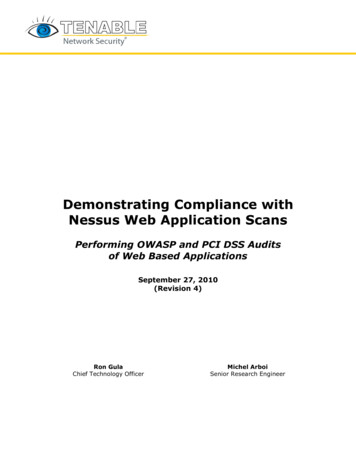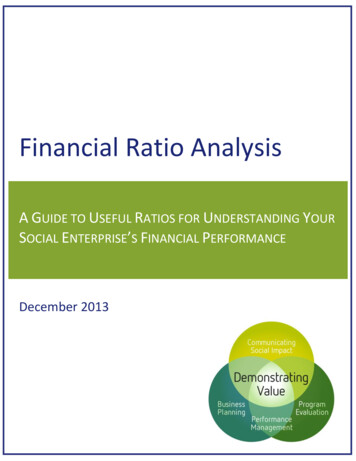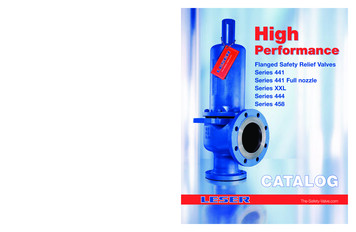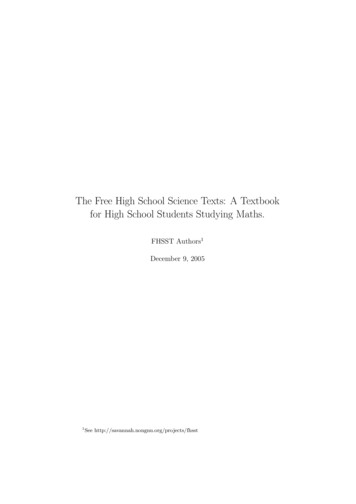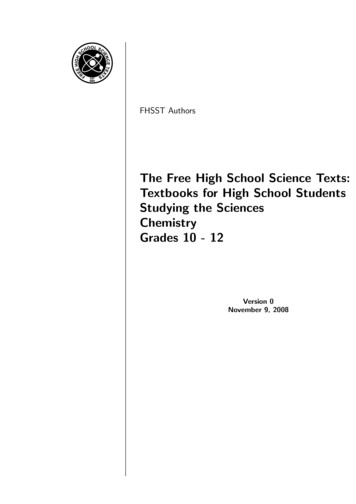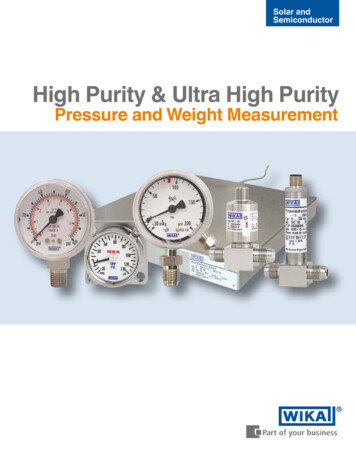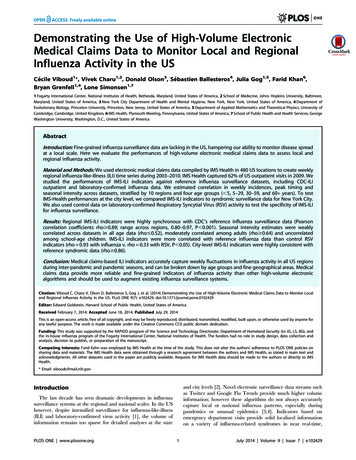
Transcription
Demonstrating the Use of High-Volume ElectronicMedical Claims Data to Monitor Local and RegionalInfluenza Activity in the USCécile Viboud1*, Vivek Charu1,2, Donald Olson3, Sébastien Ballesteros4, Julia Gog1,5, Farid Khan6,Bryan Grenfell1,4, Lone Simonsen1,71 Fogarty International Center, National Institutes of Health, Bethesda, Maryland, United States of America, 2 School of Medecine, Johns Hopkins University, Baltimore,Maryland, United States of America, 3 New York City Department of Health and Mental Hygiene, New York, New York, United States of America, 4 Department ofEvolutionary Biology, Princeton University, Princeton, New Jersey, United States of America, 5 Department of Applied Mathematics and Theoretical Physics, University ofCambridge, Cambridge, United Kingdom, 6 IMS Health, Plymouth Meeting, Pennsylvania, United States of America, 7 School of Public Health and Health Services, GeorgeWashington University, Washington, D.C., United States of AmericaAbstractIntroduction: Fine-grained influenza surveillance data are lacking in the US, hampering our ability to monitor disease spreadat a local scale. Here we evaluate the performances of high-volume electronic medical claims data to assess local andregional influenza activity.Material and Methods: We used electronic medical claims data compiled by IMS Health in 480 US locations to create weeklyregional influenza-like-illness (ILI) time series during 2003–2010. IMS Health captured 62% of US outpatient visits in 2009. Westudied the performances of IMS-ILI indicators against reference influenza surveillance datasets, including CDC-ILIoutpatient and laboratory-confirmed influenza data. We estimated correlation in weekly incidences, peak timing andseasonal intensity across datasets, stratified by 10 regions and four age groups (,5, 5–29, 30–59, and 60 years). To testIMS-Health performances at the city level, we compared IMS-ILI indicators to syndromic surveillance data for New York City.We also used control data on laboratory-confirmed Respiratory Syncytial Virus (RSV) activity to test the specificity of IMS-ILIfor influenza surveillance.Results: Regional IMS-ILI indicators were highly synchronous with CDC’s reference influenza surveillance data (Pearsoncorrelation coefficients rho 0.89; range across regions, 0.80–0.97, P,0.001). Seasonal intensity estimates were weaklycorrelated across datasets in all age data (rho#0.52), moderately correlated among adults (rho 0.64) and uncorrelatedamong school-age children. IMS-ILI indicators were more correlated with reference influenza data than control RSVindicators (rho 0.93 with influenza v. rho 0.33 with RSV, P,0.05). City-level IMS-ILI indicators were highly consistent withreference syndromic data (rho 0.86).Conclusion: Medical claims-based ILI indicators accurately capture weekly fluctuations in influenza activity in all US regionsduring inter-pandemic and pandemic seasons, and can be broken down by age groups and fine geographical areas. Medicalclaims data provide more reliable and fine-grained indicators of influenza activity than other high-volume electronicalgorithms and should be used to augment existing influenza surveillance systems.Citation: Viboud C, Charu V, Olson D, Ballesteros S, Gog J, et al. (2014) Demonstrating the Use of High-Volume Electronic Medical Claims Data to Monitor Localand Regional Influenza Activity in the US. PLoS ONE 9(7): e102429. doi:10.1371/journal.pone.0102429Editor: Edward Goldstein, Harvard School of Public Health, United States of AmericaReceived February 7, 2014; Accepted June 18, 2014; Published July 29, 2014This is an open-access article, free of all copyright, and may be freely reproduced, distributed, transmitted, modified, built upon, or otherwise used by anyone forany lawful purpose. The work is made available under the Creative Commons CC0 public domain dedication.Funding: This study was supported by the RAPIDD program of the Science and Technology Directorate, Department of Homeland Security (to JG, LS, BG), andthe in-house influenza program of the Fogarty International Center, National Institutes of Health. The funders had no role in study design, data collection andanalysis, decision to publish, or preparation of the manuscript.Competing Interests: Farid Kahn was employed by IMS Health at the time of the study. This does not alter the authors’ adherence to PLOS ONE policies onsharing data and materials. The IMS Health data were obtained through a research agreement between the authors and IMS Health, as stated in main text andacknowledgments. All other datasets used in the paper are publicly available. Requests for IMS Health data should be made to the authors or directly to IMSHealth.* Email: viboudc@mail.nih.govand city levels [2]. Novel electronic surveillance data streams suchas Twitter and Google Flu Trends provide much higher volumeinformation; however these algorithms do not always accuratelycapture local or national influenza patterns, especially duringpandemics or unusual epidemics [3,4]. Indicators based onemergency department visits provide solid localized informationon a variety of influenza-related syndromes in near real-time,IntroductionThe last decade has seen dramatic developments in influenzasurveillance systems at the regional and national scales. In the UShowever, despite intensified surveillance for influenza-like-illness(ILI) and laboratory-confirmed virus activity [1], the volume ofinformation remains too sparse for detailed analyses at the statePLOS ONE www.plosone.org1July 2014 Volume 9 Issue 7 e102429
Medical Claims Data for Influenza Surveillance in the USfrom July 2003 to June 2010. Claims data were kindly compiled byIMS Health for research purposes under a collaborative agreement with the authors.Diagnoses are coded in the physician offices using internationalclassification of diseases, 9th revisions (ICD-9). We extracted visitsfor different outcomes, including ILI and RSV, as well as the totalnumber of visits for any reason for denomination purposes. Wecreated weekly time series based on the date of office visit. SeveralILI case definitions were tested with the expectation that the mostappropriate definition would produce a large and geographicallyheterogeneous spike in disease rates during the 2009 A/H1N1influenza pandemic period, as observed in other surveillancedatasets [15], and capture the timing and intensity of influenzaepidemics in the pre-pandemic period. Further, a suitable ILIdefinition had to generate sufficient disease volume to ensurestable weekly time series at the city level.Based on preliminary analyses and previous work exploring thespatial dynamics of the 2009 influenza pandemic [11], we electedto use an ILI definition that includes a direct mention of influenza,or fever combined with a respiratory symptom, or febrile viralillness (ICD-9 487-488 OR [780.6 and (462 or 786.2)] OR079.99). Code 079.99 was identified as the most commonly useddiagnosis code for patients for whom the physician prescribedoseltamivir during the pandemic period. Few patients received aninfluenza specific code 487–488, a finding that may reflect that fewphysician offices utilized rapid influenza tests during the pandemic, following CDC guidelines to focus laboratory resources on themost severe cases [16]. To investigate the specificity of IMS-ILIdata for influenza and test the suitability of IMS data formonitoring other winter-seasonal viruses, we also created RSVdiagnoses time series (IMS-RSV), based on three RSV-specificICD-9 codes: 079.6 (RSV infection), 466.11 (RSV-bonchiolitis)and 480.1 (RSV pneumonia).Weekly incidence time series were compiled and broken downby 10 administrative regions (Text S1) and 4 age groups (under5 yrs, 5–29, 30–59, 60 and over). Regional population sizeestimates were available from the US census [17]. To test theperformances of the IMS-ILI data locally, we also compiledweekly incidence time series for 21 cities within New York Statebased on the first 3-digits of the physician’s zip code.All patient records and information were anonymized and deidentified; all records were part of routinely collected informationfor health insurance purposes. In keeping with similar epidemiological analyses of large-scale insurance administrative databases[11,12,13,14], no institutional board review was sought. Further,all statistical analyses were based on aggregated incidence timeseries rather than individual patient-level information.Reference influenza surveillance data. Publicly-availableinfluenza surveillance data from 2003–2010 were obtained fromtwo separate reference systems maintained by the CDC: (1) TheOutpatient Influenza-like Illness (ILI) Surveillance Network and(2) the US Influenza Virologic Surveillance System [2] (see also[18]). The CDC-ILI Surveillance system consists of a network ofhealthcare providers who record the weekly proportion of patientspresenting with non-specific signs and symptoms that meet a casedefinition of influenza like illness [1]. CDC Virus Surveillance datacome from ,140 laboratories throughout the US that report thetotal number of respiratory specimens tested and the number oflaboratory tests positive for influenza virus on a weekly timescale[1]. Both of these databases are available at the national andregional levels (Text S1).Negative control reference surveillance data (RSV). Wealso compiled weekly national data on laboratory-confirmed RSVactivity during 2003–2010 from the CDC’s National Respiratoryhowever, these data are not available throughout the US. Incontrast to influenza, relatively little attention has been focused onrespiratory syncytial virus (RSV), although the burden of thispathogen is increasingly recognized, particularly among pediatricage groups [5,6,7,8]. In the absence of an RSV vaccine, it isimportant to optimize the timing of RSV prophylaxis in high-riskinfants according to the local RSV season, requiring the need forimproved RSV surveillance locally [9,10].Electronic medical claims data provide a unique source ofinformation on diagnoses made by physicians and are routinelyused by pharmaceutical companies to monitor disease incidenceand anticipate drug or vaccine sales. So far however, this resourcehas remained largely untapped by epidemiologists and publichealth researchers. A few promising studies have suggested thatelectronic claims data may be useful to monitor disease patterns ofdiarrheal and respiratory viruses in the US and evaluate pediatricvaccine coverage in Germany [11,12,13,14]. Here we demonstratethe use of electronic medical claims records to monitor local andregional respiratory virus activity during pandemic and interpandemic seasons in the US.Data and MethodsEthicsAll patient records and information were anonymized and deidentified prior to being handed over to researchers; all recordswere part of routinely collected information for health insurancepurposes. Dr Farid Khan, Director of Advanced Analytics, IMSHealth, granted access to the patient data. The database is notaccessible online but researchers interested in gaining access to thedata should refer to the IMS Health website: http://www.imshealth.com/portal/site/imshealth. In keeping with similarepidemiological analyses of large-scale insurance administrativedatabases, no institutional board review was sought. Further, allstatistical analyses were based on aggregated incidence time seriesrather than individual patient-level information.General approachOur general approach is to compare weekly influenza indicatorsderived from electronic medical claims data against referenceinfluenza surveillance time series, and against control time seriesunrelated to influenza (such as RSV surveillance data). Ourstatistical measures include correlations in weekly incidences, peaktiming and seasonal estimates of epidemic intensity. Additionallywe use permutation tests to show that the estimated correlationsare stronger than those expected by chance between incidencetime series that share common winter seasonality, so as to confirmthat medical claims data capture signals truly specific of influenzaactivity. Analyses are conducted at the national, regional, and localscales, and stratified by age group.Data SourcesIMS Health Medical Claims Data. We used data maintained by IMS Health, a private data and analytics business thatcollects de-identified electronic CMS-1500 medical claim formsfrom full-time office-based active physicians throughout the US.Claims data are sourced from the practice management softwarevendors directly from the physician’s office, or from theintermediary billing systems that coordinate the insurance claimtransactions. In 2009, there were 560,433 active physicianpractices in the US of which IMS Health collected data from354,402, or an approximate coverage rate of 61.5%. IMS Healthreceives the records within 1–2 weeks of the patient’s visit. Forvalidation purposes, we focused here on historic IMS Health dataPLOS ONE www.plosone.org2July 2014 Volume 9 Issue 7 e102429
Medical Claims Data for Influenza Surveillance in the USand Enteric Virus Surveillance System [9]. These data were usedboth to validate the IMS-RSV indicator and as a non-influenzacontrol for IMS-ILI indicators. If IMS-ILI data are specific ofinfluenza activity, we would expect IMS-ILI time series to bestrongly correlated with reference influenza surveillance timeseries, and far less so with reference RSV surveillance time series.Local influenza surveillance data. To evaluate the performances of IMS-Health at a local level, we focused on New YorkCity, where disease surveillance is particularly well-established[3,19,20]. We used weekly city-level syndromic ILI surveillanceduring 2003–2010, based on 95% of emergency department visits,which are reference influenza time series included in the CDC-ILIdataset for the broader mid-Atlantic region [3,19,20].We also document 2009 pandemic disease patterns in 21 citiesor county regions of New York State based on medical claimsdata, as there was important spatial heterogeneity in pandemicactivity in this state [3,11].than influenza-specific factors. To do so, we generated 1,000simulated datasets for each region and surveillance system bypermuting seasons.A complementary test of the specificity of medical claims forinfluenza surveillance was obtained by computing the correlationbetween the IMS-ILI indicators and reference RSV surveillancetime series. These indicators share common winter seasonality butare presumably prone to independent yearly and weeklyfluctuations specific to influenza and RSV.Influenza and RSV peak timing. We compared the peaktiming of disease activity each season (defined as the week ofmaximum weekly IMS- ILI incidence, IMS-RSV incidence,CDC-ILI incidence, CDC influenza virus activity, and CDCRSV activity in any given season). We computed the difference inpeak timing per season, and report the average and range ofdifferences by region.Seasonal intensity of influenza and RSV epidemics. Toobtain a summary measure of influenza intensity by season, weapplied Serfling seasonal regression model to both medical claimsand reference ILI time series [3,21,22,23]. The Serfling approachassumes that background non-influenza ILI incidence follows aseasonal pattern, and that background seasonality does notfluctuate between years. In this approach, a linear regressionmodel including harmonic terms and time trends is fitted to noninfluenza weeks (May-Oct), after exclusion of both pandemicseasons. The model provides a seasonal baseline of the expectedlevel of ILI activity when influenza does not circulate. Inconsequence, the burden of influenza on ILI can be estimated asthe cumulative difference between observed and baseline ILI eachrespiratory season, which is a proxy for seasonal influenzaintensity. We repeated the analysis for all age and age-specificdata. A similar approach was used to compute seasonal estimatesof RSV intensity from weekly IMS-RSV indicators.From laboratory-confirmed influenza time series, we definedinfluenza seasonal intensity as the total virus percent positive eachrespiratory season ( sum of all influenza positive specimens/sumof all specimens tested during the season), as in CDC summaryreports [2]. A similar approach was used to compute RSVintensity from weekly laboratory-confirmed RSV surveillance. Noage breakdown was available for CDC’s viral activity data.All analyses where performed in R; scripts are available fromthe authors upon request.Statistical approachStudy period and spatial scales. We compared weekly ILIand RSV indicators based on medical claims with weeklyreference surveillance data from July 2003 to June 2010. Thisperiod included 6 pre-pandemic seasons (July 2003–June 2004,July 2004–June 2005, July 2005–June 2006, July 2006–June 2007,July 2007–June 2008, July 2008–April 2009), and the spring andfall 2009 A/H1N1 pandemic waves (May–Aug 2009 andSeptember 2009–June 2010).The spatial scale of most of our analyses was the region or city,except for comparisons with RSV laboratory-confirmed surveillance, for which retrospective data were available only nationally.Influenza incidence measures. For week t and region i, wedefined the IMS-ILI incidence indicator as the ratio of all ILI visitsin the IMS dataset to the total number of IMS visits that week, per100,000 population, as in [11]:IMS ILI incidence(t,i) [(IMS ILIt,i/IMS visitst,i)]*[(populationi/100,000)].This indicator is an extension of the ILI incidence ratio used byCDC and New York City [18], with additional standardization forpopulation size. The IMS-RSV incidence indicator was created inthe same way as the IMS-ILI indicator. To aggregate IMS datanationally, we weighted weekly regional incidence estimates by thenumber of physicians participating in surveillance in each weekand region.We defined laboratory-confirmed influenza virus activity inregion i and week t as the standardized number of influenzaspecimens testing positive for influenza, following:Virus activity(t,i) flu positivest,i,/total specimens testeds,iWhere flu positivest,i, is the number of samples testing positive forinfluenza in week t and region i, total specimens testeds,i is thetotal number of samples tested in influenza season s and region i[7]. An alternative is to standardize by the weekly number ofspecimens tested (weekly percent virus positive), but this indicatoris more sensitive to sampling issues at the regional level, especiallyat the start and end of the influenza season. We used the samestandardization for RSV laboratory-surveillance data.Weekly correlation between surveillance time series. Toinvestigate whether the IMS-ILI indicator provided accuratemeasurement of influenza epidemic patterns and following earlierwork [3,18], we computed the week-by-week Pearson’s correlationbetween IMS-ILI and reference influenza surveillance time seriesSince the estimated correlation could be explained in part byshared winter seasonality across disease datasets, we also computedthe expected level of correlation under the null hypothesis wherecorrelation originates exclusively from winter seasonality ratherPLOS ONE www.plosone.orgResultsRegional comparisonsOverall patterns in influenza incidence. Weekly regionalinfluenza time series are displayed in Figure 1 for threesurveillance systems for the period 2003–2010: IMS-ILI, CDCILI and CDC laboratory-confirmed influenza viral activity. Alldatasets were characterized by strong winter seasonal peaks duringNovember-March, except for the unusual occurrence of springand fall pandemic peaks in 2009 in all regions. Between-seasonfluctuations in influenza intensity were also observed, as expectedfrom variation in circulating strains and levels of populationimmunity. All three surveillance systems captured the moderatelysized spring 2009 pandemic wave in New England, and a largespring wave in the New York City metropolitan region. In otherregions, laboratory-confirmed virus acti
IMS Health Medical Claims Data. We used data main-tained by IMS Health, a private data and analytics business that collects de-identified electronic CMS-1500 medical claim forms from full-time office-based active physicians throughout the US. Claims data are sourc
